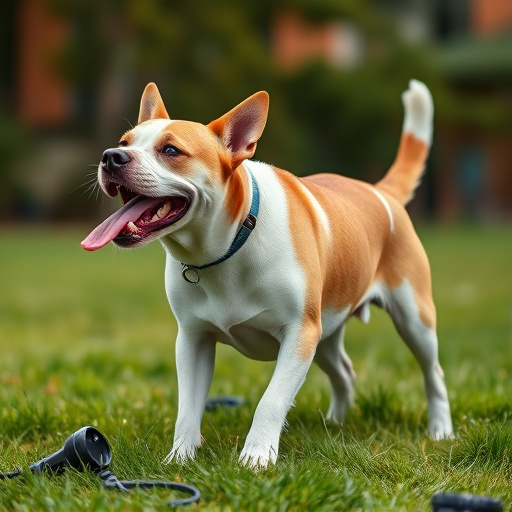Dog repellent modes, like electronic deterrents using vibration, static shock or citronella spray, offer safe, effective solutions for managing aggressive pet behaviors without causing harm. Advanced devices incorporate ultrasonic sounds, mild electrical impulses, and GPS tracking. While successful with many breeds, their effectiveness varies based on individual temperament and training. Key to optimal use is proper training, safety protocols (including veterinary approval), regular inspection, and tailored advice from professionals.
“Unraveling effective solutions for managing aggressive dog behavior, this article explores an innovative approach: electronic deterrent devices. We delve into the intricate world of canine psychology, understanding the roots of aggression and their unique needs. With a comprehensive overview of various electronic repellents, we weigh their advantages and disadvantages, particularly in relation to Dog Repellent Modes for Aggressive Pets. Furthermore, essential training and safety guidelines are highlighted for responsible and effective use.”
- Understanding Aggressive Dog Behavior and Their Needs
- Types of Electronic Dog Deterrent Devices: A Comprehensive Overview
- Advantages and Disadvantages of Using Repellent Modes for Aggressive Pets
- Training and Safety Considerations for Effective Use of Dog Repellent Devices
Understanding Aggressive Dog Behavior and Their Needs
Aggressive dog behavior often stems from unmet needs or a lack of proper training and socialization. Understanding these behaviors is crucial when selecting an effective dog repellent for aggressive pets. Dogs may display aggression due to territorial instincts, fear, anxiety, or past traumatic experiences. By recognizing these triggers, pet owners can choose the most suitable Dog Repellent Modes tailored to their dog’s specific behavior patterns.
For instance, electronic deterrents designed for aggressive dogs offer various modes like vibration, static shock, or citronella spray. These methods aim to disrupt unwanted behaviors without causing harm. The key is finding a device that provides enough stimulation to interrupt the aggression while remaining humane and safe for the dog’s overall well-being.
Types of Electronic Dog Deterrent Devices: A Comprehensive Overview
Electronic dog deterrent devices have evolved significantly, offering a range of options for pet owners dealing with aggressive behavior in their canines. These tools are designed to correct unwanted actions without causing harm, employing various techniques to repel dogs safely and effectively. One prominent mode of action is the use of sound, where high-frequency ultrasonic waves are emitted, inaudible to humans but irritating to dogs. This method can be particularly useful for deterring barking or protecting property from intruding dogs.
Another popular approach involves the application of safe, non-toxic collars that deliver mild electrical impulses when a dog displays aggressive behavior. These devices often have adjustable sensitivity levels, allowing them to accommodate different training stages and individual pet needs. Additionally, some advanced models incorporate GPS tracking, providing real-time location data and adding another layer of control for concerned owners. These innovative technologies cater to the diverse requirements of dog owners, addressing specific issues like barking, territorial aggression, or protecting against potential threats in various settings.
Advantages and Disadvantages of Using Repellent Modes for Aggressive Pets
The use of dog repellent modes for aggressive pets offers several advantages. These devices employ various electronic stimuli, such as sounds and vibrations, to deter unwanted behavior without causing harm. They can be highly effective in training dogs to respond differently to specific triggers, thereby reducing aggression. Additionally, they provide a non-lethal alternative to traditional shock collars, appealing to pet owners who prioritize humane treatment of their animals.
However, there are also disadvantages to consider. The effectiveness of these modes varies greatly depending on the dog’s breed, temperament, and training. Some dogs may become desensitized to the stimuli over time, rendering the device less useful. Furthermore, improper use or incorrect setting can lead to discomfort or even fear in the animal. It’s crucial for owners to thoroughly understand how these devices work and follow professional guidance for optimal and ethical use.
Training and Safety Considerations for Effective Use of Dog Repellent Devices
When considering electronic dog deterrent devices, training and safety are paramount for effective use. These devices often employ various repelling modes, including ultrasonic sounds, static electricity, or spray, to deter aggressive pet behavior like barking or biting. However, simply deploying such tools is not enough; proper training is essential to teach your dog alternative behaviors in response to triggers. For instance, positive reinforcement techniques can help condition your pet to associate certain environments or stimuli with rewards rather than deterrents.
Safety considerations are equally critical. Ensure the device is designed for outdoor use and approved by veterinary professionals to avoid potential health risks. Regularly inspect the equipment for wear and tear, and follow manufacturer instructions for proper setup and usage. It’s crucial to maintain open communication with your veterinarian or animal behaviorist throughout the process, as they can offer tailored advice based on your dog’s unique needs and temperament.
In conclusion, understanding aggressive dog behavior and their underlying needs is crucial before employing any humane dog deterrent electronic device. With various options available, from static shock to ultrasonic repellents, each with its advantages and disadvantages, the right choice depends on your pet’s specific situation. Training and safety considerations cannot be overlooked to ensure effective and responsible use of these devices, ultimately helping to manage aggressive behaviors while prioritizing your dog’s well-being. For those seeking Dog Repellent Modes for Aggressive Pets, a thorough understanding of these factors will contribute to successful outcomes.
